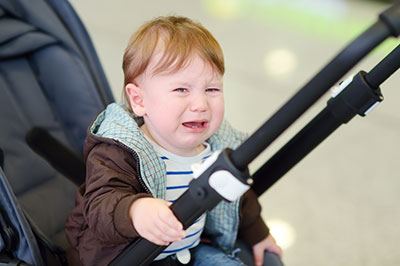Babies and toddlers generally like strolling, as they can explore the new world surrounding them. However, older babies might show resistance and not want to use strollers anymore.
This leads us to the main question: What to do if a baby hates stroller & how to make them more comfortable while strolling around?
The advisor offers you the best tips & tricks on how to lure little ones into strollers, guidelines to make them cozier, and alternatives if they still hate restraints.
More...
Take away key points:
Why do some children fuss in the stroller, car seat, or bouncy seat, screaming bloody murder?
Below you can learn the leading cause for discomfort and how to calm your children down while strapping them in the restraint.
Why does a child hate a car seat, stroller, or bouncer?
There are multiple reasons why a little one might hate car seats, strollers, baby carriers/swings, or bouncy seats, including:

When will a baby stop disliking a stroller, car seat, or bouncer?
As a baby ages, they will overpass the crying and fussiness inside the stroller, bouncer, or seat. Kids mostly cry during their first three months of life. However, colicky or premature children tend to overcome this after the first few months of their life.
In addition, some babies never adapt to restraints, so parents shouldn't be discouraged when their son/daughter still doesn't find physical comfort in constraints. It's not a big deal with swings or bouncers - if the baby dislikes them, you won't use the items.
However, there's no room for negotiation when you're on the road. Putting kids into the stroller is essential for all parents when out of the house. So, if your baby still hates restraint straps, they must be strapped for maximum safety standards.
Best tips to calm the baby who hates a stroller, car seat, or bouncer
Several things help you soothe your little one and acclimate them to the stroller or similar restraint to finish your errands or give your hands a break. These include:

What are alternatives if your infant still dislikes a stroller?
You must have a good backup plan when a child doesn't want to sit in the stroller and ride around. Baby-wearing is an excellent idea instead of a stroller or similar restraint.
A mom should choose a supportive baby carrier keeping her baby's hips and providing good weight distribution to protect and support her body's balance. You can fold and place them inside the stroller basket or diaper bag. Your baby can sleep in the carrier when tired, and the unit cannot hurt them. Once they fall asleep, you can move them to the crib to sleep on their back and prevent SIDS.
FAQs
Why does my baby not like the pram?
There are multiple reasons why babies won't sit in the stroller. For instance, they can be bored, and you must think of fun and entertaining ways to keep them in the stroller, seat, or similar restraints for an extended period.

How do I get my baby to like walking?
You can reward your children with toys or similar funny objects to make them like walking. You can practice inside their room, with your help to be stable enough, and give them rewards and positive encouragement once they 'cross the finish line.'
Why does my baby scream in the car seat?
There are various reasons for a baby screaming in the car seats, including:
- Discomfort
- Sensitivity
- Loneliness
- Temperament
- Car sickness
- Colicky and premature children
How can I make my baby's stroller more comfortable?
You must check the manufacturer's instructions and use the age-appropriate car seat for infants. In addition, you can use rear-facing models to let your baby see you all the time.
Another option is to use head and body support (pillows) to make children cozier. Finally, bring toys for more fun on the road.
Final Thoughts
Don't be discouraged if you notice baby hates stroller and your child screams in the stroller/car seat. Wait for a while and be creative - think of multiple ways to keep them entertained in the restraints.
However, always follow the experts' advice and encourage your little ones until they no longer feel uncomfortable in restraints.
